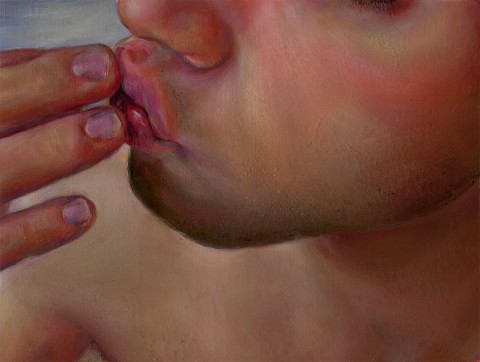In each fragment of the figure there is a rawness to the exposed flesh – as the colors push past naturalism to portray a perpetual flush. It is as if a layer of skin has been peeled back, revealing not only the blood and bone beneath, but an emotional core: the telltale blush that betrays our most hidden fears and desires. Between desire and disgust – the intimacy of details is contrasted with the disintegration of the surface. The paint is puckered, pulled – even torn through to reveal the imprimatura: as if the paint itself has been ravaged by sentiment. It mimics an interior disruption that the flushed skin only implies.
The images are a mute dialog of mixed signals, of skin pressing to skin, where the mouth and hands attempt a crude sign language that confounds more than it reveals. Is it frustration or desire, fear or regret? The emotions are as ambiguous as the context. Each image focuses in on a point of contact: fingertips pull and stretch the skin, press apart the lips, teeth bite into the knuckles of a raised fist.
Influenced by Holbein’s sensitive portrayal of the frailty of flesh (both in his portrait of wife and child in Basel, and in that of Sir Thomas More at the Frick) and also drawing on the Antonello da Messina exhibition at the Metropolitan. In these paintings there is an attention to detail that seems to become a reflection of desire. Each individual hair stroked by the brush creates a heightened intimacy, makes us privy to an intensity of emotion that creates a unique focus on the object of the gaze. So would a lover observe, in the midst of an argument, the intricacies of the other’s skin, even singling out to notice the individual hairs at the nape of the neck, combing them with the eyes. All this, done perhaps in annoyance or anger, but also with a fondness that is both bittersweet and kind.
